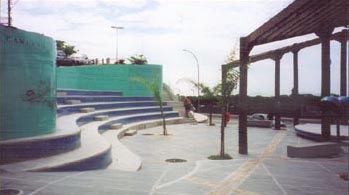| Favelas |
| GSD
Prize awarded for transforming Rio Slums By Ken Gewertz |
A massive project that is transforming Rio de Janeiro's squalid shantytowns into functioning, integrated neighborhoods has won the graduate School of Design's Veronica Rudge Green Prize in Urban Design.
Argentinean-born architect Jorge Mario JŠuregui, whose firm has materialized this transformation - known as the Favela-Bairro Project - received the award in a special ceremony at Gund Hall on Dec.6. An exhibition of large-scale color photos of the project by Jason Schmidt, along with maps and drawings, can be seen in the Gund Hall lobby through Jan. 12.
Rodolfo Machado, professor in practice of architecture and urban design, and chair of the jury that selected JŠuregui's project, said that the Rio-based firm has "demonstrated the power of their urban design to realize social change and engage marginalized people in the revitalization of their own communities. This diligent and ethical professional team models a progressive, more holistic approach to urban design, one that recognizes the value of social research and reinvestment in neighborhoods, rather than the outmoded practice of demolition and displacement."
Long considered a blight on the urban landscape, Rio de Janeiro's shantytowns differ from those of most other South American cities in that many of them occupy prime real estate, often within the city itself rather than on its outskirts.
The reason is that in the early days of settlement, wealthy inhabitants laid claim to sites near the harbor, leaving the steep, inaccessible hillsides to the poor. Many of these communities command spectacular views of the ocean and the city below and such famous Rio landmarks as the Sugarloaf and the mountaintop statue of Christ.

Aerial
view favela of Vidigal in context.
Some of these shantytowns, or favelas, are more than 100 years old. Others are much newer. In total, they contain about a third of the city's inhabitants, many of whom work as doormen, and domestic help. Most of the favelas lack adequate infrastructure or drivable roads, and what electricity they have has been stolen from city power sources and brought into the favela via tangles of improvised cable.
In the past, city authorities have tried to eradicate the favelas, which have been seen as breeding ground of crime and drug dealing. But these attempts, based on a traditional "slum clearance" model, have failed to have any lasting effect.
Rather than doing away with the favelas, JŠuregui's approach has been to integrate them into the city fabric by transforming them into real neighborhoods or bairros. This has meant replacing muddy dirt paths with paved walkways, creating streets capable of sustaining vehicular traffic, building sewer systems and cleaning up polluted streams and rivers, and providing communities with social centers, clinics, daycare centers, and athletic complexes. These changes have allowed the disenfranchised inhabitants of the favelas to participate in the life of the city.
The work was preceded by a long period of research that addressed geotechnical, economic, and land ownership issues, as well as sociological, psychological, and aesthetic concerns. The team kept their focus on the specific project rather than trying to apply universal formulas for urban improvement.
According to Machado, who visited these sites along with other members of the prize committee, the Favela-Bairro Project "appears to be soaked in kindness and respect for the inhabitants; the opposite of misanthropic, it exudes a warmth that comes from genuine understanding of the real conditions in the favelas plus a deep, rare communion between the team and the people with whom it works."
"Favela-Bairro" has impacted an estimated 450.000 people in 105 shantytowns to date. Now in its fifth year, the program has been recognized through several international awards, including the prestigious "Habitat Award" from the United Nations, and has received funding from numerous international agencies. Program sponsors include the Inter-American Development Bank and the European Union.
A native of Rosario, Argentina,, JŠuregui studied architecture at the National University at Rosario, where he served as a professor from 1973 through 1976. He went on to earn a graduate degree in architecture and urban planning at the Federal University in Rio in 1991.
The Veronica Rudge Green Prize in Urban Design is the foremost award recognizing achievement in this field. The award was established in 1986 on the occasion of Harvard University's 350th anniversary, and the 50th anniversary of Harvard Design School. The prize is awarded biannually to recognize excellence in urban design with emphasis on projects that contribute to the public realm of a city and improve the quality of urban life.
To be considered for the prize, projects must be larger in scope than single building, and have been constructed within the last 10 years. Nominations are submitted by a panel of distinguished critics, academics, and practitioners in the fields of architecture, landscape architecture and urban design. Prize recipients are presented with a monetary award and certificate.

Articulation Square
Favela-Neighbourhood of Vidigal